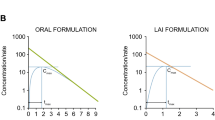Abstract
Purpose
The aim of the current manuscript is to develop and validate a level A in vitro-in vivo correlation (IVIVC) for veliparib extended-release (ER) tablet formulations.
Methods
The in vitro release profiles of veliparib formulations were determined using USP Dissolution Apparatus 2 with 900 mL of 0.1 N HCl at 75 rpm. In a clinical study, 24 subjects with solid tumors received one of the ER formulations (200 mg): fast (Formulation A), intermediate (Formulation B), and slow (Formulation C), and two 100 mg immediate release capsules (Formulation D). Blood samples were collected over a period of 48 h and analyzed using LCMS/MS. A linear correlation model was developed using fraction absorbed and fraction dissolved data from formulations A and B. Besides assessing internal predictability, external predictability was evaluated using formation C. Prediction errors were estimated for maximum observed plasma concentration (Cmax) and area under the plasma-concentration time curve from zero to last measured time point (AUCt) to determine the predictive ability of the correlation.
Results
There was a significant linear relationship (r2 = 0.944) between the fraction of drug absorbed and the fraction of drug dissolved. The prediction error using the internal validation for Cmax and AUCt were below 15% for the individual formulations and below 10% for the average. The prediction error in AUCt and Cmax for formulation C was 5% and 11%, respectively.
Conclusions
A level A IVIVC for the veliparib ER tablet formulation was established. The IVIVC may allow the associated dissolution data to be used as a surrogate for bioavailability.





Similar content being viewed by others
Abbreviations
- AUCinf :
-
Area under the plasma-concentration time curve from zero to infinity
- AUCt :
-
Area under the plasma-concentration time curve from zero to last measured time point
- Cmax :
-
Maximum observed plasma concentration
- ER:
-
Extended-release
- IVIVC:
-
In vitro in vivo correlation
- PARP:
-
Poly (ADP-ribose) polymerase
- PE:
-
Prediction error
- Tmax :
-
Time to maximum observed plasma concentration
- T1/2 :
-
Terminal half-life
References
Wagner LM. Profile of veliparib and its potential in the treatment of solid tumors. OncoTargets Ther. 2015;8:1931–9.
Donawho CK, Luo Y, Luo Y, Penning TD, Bauch JL, Bouska JJ, et al. ABT-888, an orally active poly(ADP-ribose) polymerase inhibitor that potentiates DNA-damaging agents in preclinical tumor models. Clin. Cancer res. Off. J. Am. Assoc. Cancer Res. 2007;13:2728–37.
Jagtap P, Szabó C. Poly(ADP-ribose) polymerase and the therapeutic effects of its inhibitors. Nat Rev Drug Discov. 2005;4:421–40.
Salem AH, Giranda VL, Mostafa NM. Population pharmacokinetic modeling of veliparib (ABT-888) in patients with non-hematologic malignancies. Clin Pharmacokinet. 2014;53:479–88.
Coleman RL, Sill MW, Bell-McGuinn K, Aghajanian C, Gray HJ, Tewari KS, et al. A phase II evaluation of the potent, highly selective PARP inhibitor veliparib in the treatment of persistent or recurrent epithelial ovarian, fallopian tube, or primary peritoneal cancer in patients who carry a germline BRCA1 or BRCA2 mutation - an NRG oncology/gynecologic oncology group study. Gynecol Oncol. 2015;137:386–91.
Emami J. In vitro - in vivo correlation: from theory to applications. J. Pharm. Pharm. Sci. Publ. Can. Soc. pharm. Sci. Soc. can. Sci. Pharm. 2006;9:169–89.
Guidance for Industry: Extended Release Oral Dosage Forms: Development, Evaluation, and Application of In vitro / In vivo Correlations. FDA, CDER. 1997.
Puhalla S, Beumer JH, Pahuja S, Joseph AL, Tawbi HAH, Stoller RG, et al. Final results of a phase 1 syudy of single-agent veliparib in patient swith either BRCA1/2-mutated cancer, platinum-refractory ovarian, or basal-like breast cancer. J Clin Oncol. 2014; 32:5s
Mirza T, Bykadi SA, Ellison CD, Yang Y, Davit BM, Khan MA. Use of in vitro-in vivo correlation to predict the pharmacokinetics of several products containing a BCS class 1 drug in extended release matrices. Pharm Res. 2013;30:179–90.
Author information
Authors and Affiliations
Corresponding author
Ethics declarations
Conflict of Interest
This study was sponsored by AbbVie Inc. AbbVie Inc. contributed to the study design; research; data interpretation; and writing, review and approval of the manuscript for publication. Rajendar K Mittapalli, Silpa Nuthalapati, Alyssa Delke DeBord and Hao Xiong are employees of AbbVie Inc. and may hold AbbVie stocks or options.
Electronic supplementary material
Supplemental Table I
(DOCX 25 kb)
Supplemental Table II
(DOCX 25 kb)
Rights and permissions
About this article
Cite this article
Mittapalli, R.K., Nuthalapati, S., Delke DeBord, A.E. et al. Development of a Level A in Vitro-in Vivo Correlation for Veliparib (ABT-888) Extended Release Tablet Formulation. Pharm Res 34, 1187–1192 (2017). https://doi.org/10.1007/s11095-017-2133-3
Received:
Accepted:
Published:
Issue Date:
DOI: https://doi.org/10.1007/s11095-017-2133-3




